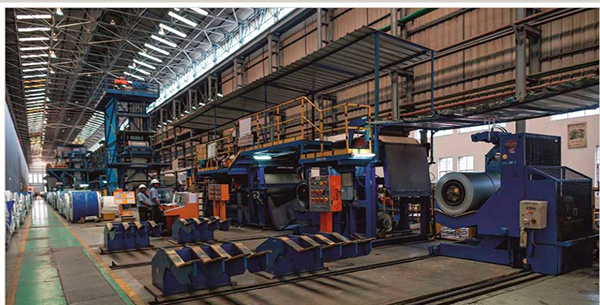ALUMINIUM ZINC ALLOY COATING PROCESS

ALUMINIUM ZINC ALLOY COATING PROCESS
NSAIL’s Nationalume, the hot-dipped coating product is comprised of 55% aluminum, 43.5% zinc, and 1.5% silicon. This product is known by many different trade names throughout the world. Nationalume is one of the preferred names.
The aluminum-zinc alloy-coated steel sheet has proven to be an excellent product for long-life Roofing & Cladding, especially low slope roofing on industrial buildings.[ It has been widely applied as bare (unpainted) sheet with the coating being directly exposed to the atmosphere. ]
The product is also used as a substrate for prepainted sheet and this use has also grown significantly. The ASTM product specification for 55% Al-Zn coated sheet is A792/A792M, and the prepainted sheet version is specified in A755/A755M.
The resultant products are far superior in terms of adherence to zinc coating and surface finish. Furthermore, they meet international standards such as ASTM, JIS, EN and Australian as well as Indian standards.
[Corrosion performance data comparing the performance of 55% Al-Zn with galvanized coatings indicate that the performance is superior than galvanize coatings in all three types of environments– marine, industrial and rural.The unique dendritic structure of the alloy coating is now widely recognized as the primary reason for the improved corrosion resistance of the 55% Al-Zn coating. When it is exposed to the environment, the zinc rich areas corrode first. Since these areas are located in a labyrinth of interdendritic regions in the coating, the products of corrosion tend to fill the interdendritic interstices and the corrosion rate decreases. This leads to a flattening, parabolic corrosion rate curve in most environments. This contrast with the linear behaviour typical of galvanize.Corrosion of a 55% Al-Zn coating is therefore not the uniform thinning process of a galvanized coating.During the early stages of the product life, the aluminum-rich dendrites are largely unaffected by most environments. In a sense, the aluminum-rich dendrites perform like a barrier coating, while the zinc-rich areas provide the galvanic protection that is needed to minimize the tendency for rust staining at sheared edges and other areas of exposed steel.]